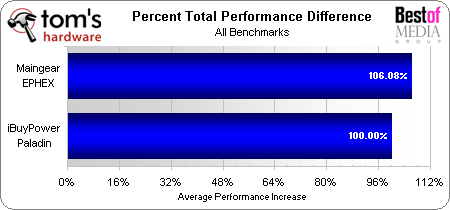Battle Of The Boutique Behemoths: iBuyPower Vs. Maingear PC
Conclusion
Maingear won today’s performance shootout with its meticulously-crafted and tuned creation, averaging 6% better performance than the similarly-priced system from iBuyPower sporting an unsanctioned overclock.
iBuyPower, on the other hand, included a more expensive motherboard and processor. But rather than tweak its system’s overclocking capability to the max, its builders instead settled for increasing CPU multipliers, while leaving nearly everything else at BIOS defaults. In other words, Maingear put more effort into its system, and that’s something buyers of ultra-expensive equipment should be able to appreciate.
But both companies offer many of the same parts. We were curious to see what would happen if we configured the iBuyPower PC with Maingear’s motherboard, processor, graphics, and lack of Blu-ray disk burner. So, we plugged these options into iBuyPower’s Web site and found that we could have saved over $1,000 by selecting the less detail-oriented build. That difference is hard to justify simply by looking at Maingear’s high-end case, which isn’t available from iBuyPower.
Another problem is that getting Maingear performance from an iBuyPower PC will cost the buyer time, since iBuyPower doesn’t optimize system tuning (and doing so on your own is not explicitly covered under the company's warranty). If you’re willing to spend time tuning a system to save $1,000, you’ve probably already built your own.
It’s easy for us to recommend Maingear to anyone who wants the fastest possible system and is willing to pay for it, but iBuyPower appears to be a better-value company for less discriminating buyers who simply don’t want to handle the components themselves. iBuyPower’s value is further enhanced with a three-year warranty period that Maingear buyers must purchase as a $200 option (Ed.: be aware that this pro evaporates if you tune the system yourself).
Note to Maingear: buyers at this market level are often willing to pay more for higher-level craftsmanship, but out-of-pocket warranty options diminish the purchase experience. The extra coverage is expected, should be representative of build-quality, and should reflect confidence that the overclocked settings you've chosen still offer longevity (Ed.: After this review was published, Maingear changed its warranty period to three years, standard, at no additional cost).
Get Tom's Hardware's best news and in-depth reviews, straight to your inbox.
-
johnsmithvag What a stupid and pointless article. Thanks again for wasting my time. Really, i mean, if i wanted to see an add i'd just look slightly to the right.Reply -
sepuko Why do the systems have different video driver packages? You call that a fair comparison ?Reply -
jonbach Bravo for the editor's note on page 9. I'm downright excited to see CNET and Tom's Hardware giving attention to keeping system builders honest when it comes to system reviews. In addition, I do think that in the end, most consumers value a problem free process and fast, reliable support even more than they value a few percentage points performance gain (Or am I off base here? Please comment!).Reply
Yet that aspect of system builders is missed by the current review process. I'd love to see even more about the ordering and support process, but you're right that would require a "secret shopper" method.
I can't speak for all boutique builders, but I bet you would find many of us extremely receptive to any ideas you may have on how we can help mitigate the costs of a secret shopper program in a way that preserves the fairness and anonymity of the review process.
Jon Bach
President - Puget Systems
http://www.pugetsystems.com -
Crashman sepukoWhy do the systems have different video driver packages? You call that a fair comparison ?Reply
That's the way they shipped them, so it's the ONLY way to run a fair comparison: NO MODIFICATIONS.
Also notice that the system with the newest drivers lost. We tried ripping out the newer drivers and putting in the older ones: a few benchmarks lost around 0.1-1.0 FPS with the "matching" drivers, but it really wasn't worth the time to finish retesting since it only made the worst-performing system perform slightly worse than it had when it first lost. An increased loss of less than 1% (average) is still a loss and the difference isn't noteworthy. -
Crashman hustler539Wheres 1920 x 1200?Who buys a $4k+ system to game at 1024 x 768?Reply
Who buys a $4k system to game at 1920? The 2560 results are there. -
ta152h They're ugly systems, as usual.Reply
If they are going to put in premium parts, why do they buy ugly cases to stick them in? When are PC makers going to put more attention into more attractive cases?
$4,000 for an ugly brick. Whatever. -
neiroatopelcc I like seeing a silverstone chassis in there. Nice to know they ain't just tossing all the nice stuff into an average garbage bin from antec or something (like we cost concious people do).Reply

